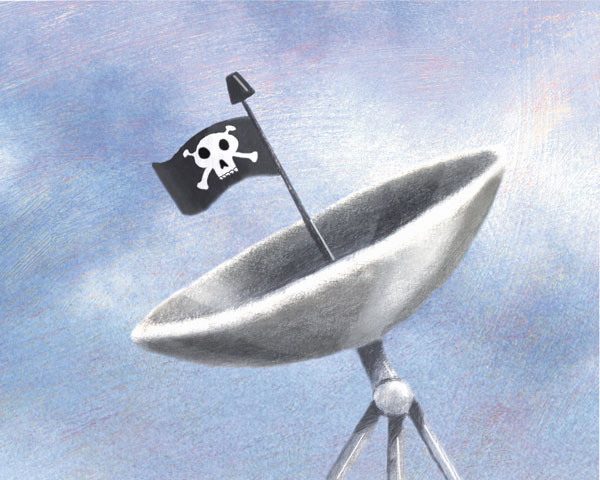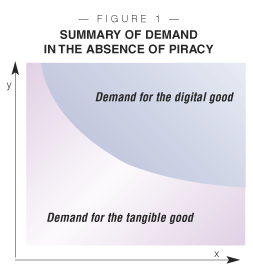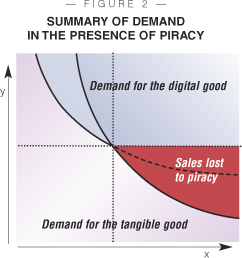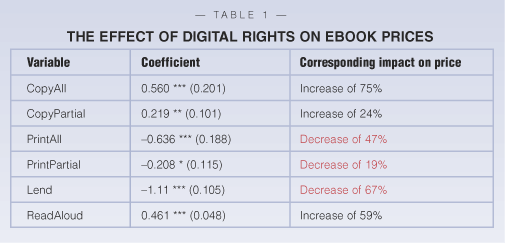
 n the many industries making the wrenching transition from physical to digital products – music, video, publishing – the effective management of digital rights is a crucial challenge. Increasingly, products once sold exclusively as tangible goods are now available as pure digital goods. These digital goods have a number of attractive properties for sellers. They’re much cheaper to produce and deliver, and they may include electronic features that enhance the user experience.
n the many industries making the wrenching transition from physical to digital products – music, video, publishing – the effective management of digital rights is a crucial challenge. Increasingly, products once sold exclusively as tangible goods are now available as pure digital goods. These digital goods have a number of attractive properties for sellers. They’re much cheaper to produce and deliver, and they may include electronic features that enhance the user experience.
But the process of transition toward digitizing products is uncertain, and currently incomplete. This presents sellers with difficult technological and business decisions. On the one hand, most current sales continue to be in the form of tangible goods, and digital goods are seen as imperfect substitutes for their physical counterparts. On the other hand, technologically savvy customers are likely to view digital products as being of higher value, and possibly as better substitutes. And most crucially, digital goods are subject to piracy, which can affect demand for both nascent digital goods and the corresponding physical goods.
How can companies price digital goods in a way that both maximizes profits and minimizes the incentives for piracy? How can they control the quality of digital goods and the extent to which their presence leads to piracy? The answer lies in the management of the rights associated with digital goods.
Yes, the technological challenges of digital rights management (DRM) are gradually being addressed by the emergence of viable industry-specific platforms like iTunes, which uses the FairPlay DRM technology to secure its music. But effective DRM requires the striking of a delicate balance. An insufficient level of digital rights can result in the premature failure of a digital initiative, as illustrated by early emusic services. And granting digital rights that are too extensive can lead to cannibalization of established sales of physical goods – or to widespread digital piracy, which can wipe out a nascent digital industry. For example, the right to download (rather than stream) digital audio files increases the desirability of purchasing legal digital music. But it also increases the threat of digital piracy over file-sharing networks. The right to print a digital book encourages ebook adoption, but enables the creation of pirated PDF copies.
 s part of an effort to better understand the role of digital rights, we developed an economic model that characterizes the value of digital rights when products are sold both embedded in tangible physical artifacts and as pure digital goods, and when granting digital rights may also affect the extent of digital piracy. Then we tested it by examining sales of one form of digital content: ebooks.
s part of an effort to better understand the role of digital rights, we developed an economic model that characterizes the value of digital rights when products are sold both embedded in tangible physical artifacts and as pure digital goods, and when granting digital rights may also affect the extent of digital piracy. Then we tested it by examining sales of one form of digital content: ebooks.
An Economic Model of Digital Rights
We analyze the decisions of a seller who produces two versions of a product: a physical (tangible) good and a digital good. Consumers are familiar with the tangible good and perceive it to be of a constant and well-understood level of quality. The quality of the digital good, on the other hand, is determined by the level to which the seller grants rights to buyers of the digital goods – the right to print an ebook, to backup a downloaded video file, or to burn music CD’s, for example. The range of possible settings for each digital right is determined by the DRM platform used by the seller and has pre-specified minimum and maximum levels. Under Adobe’s DRM platform for ebooks, for example, a seller can offer unlimited printing, or no printing whatsoever, or can specify a fixed number of pages that can be printed during each time period. As a general rule, granting a buyer a higher level of digital rights imposes no direct costs on the seller and increases the value the buyer realizes from the digital good.
“Sellers should focus on enhancing the digital consumption experience and not on trying to digitally recreate their physical products.” |
Of course, in addition to the legal physical and digital versions, there may be a pirated digital version of the good. And the quality of the pirated good is also determined by the level to which the seller grants different digital rights to buyers of the digital good. Why? Because, as previously mentioned, increasing the level of rights granted to legal users often has an unintended consequence: it facilitates the creation and spreading of higher-quality pirated versions as well.
Our model, which is mapped out in Figure 1, posits that customers are heterogeneous along two dimensions. First, how much they value digital quality, or the granting of digital rights (represented by the parameter on the y axis). The higher the value of y, the more the customer values digital goods of fixed quality. The second dimension (the x axis) represents the customer's relative preferences for tangible versus digital goods. All else being equal, customers with a higher value of x place a higher value on the digital good and a lower value on the physical good than a customer indexed by a lower value of x.
 To further capture diversity in customer preferences for the tangible good, the digital good, and the pirated good across industries, we use a preference diversity parameter t. A higher value of t indicates that, on average, customers vary more in their relative preferences for the tangible and digital goods. We, therefore, use this as a (inverse) measure of the technological sophistication of the seller’s target customers. As shown in Figure 1, when piracy isn't an issue, customers in the upper-shaded area prefer the digital good to the tangible good, after accounting for the price differences between the two goods.
To further capture diversity in customer preferences for the tangible good, the digital good, and the pirated good across industries, we use a preference diversity parameter t. A higher value of t indicates that, on average, customers vary more in their relative preferences for the tangible and digital goods. We, therefore, use this as a (inverse) measure of the technological sophistication of the seller’s target customers. As shown in Figure 1, when piracy isn't an issue, customers in the upper-shaded area prefer the digital good to the tangible good, after accounting for the price differences between the two goods.
So, what happens to prices when customers choose between the tangible good and the digital good in the absence of piracy? The price customers are willing to pay for the digital good (1) rises as the price of the tangible good rises; (2) rises as the quality of the digital good rises, and consequently, as the level of each digital right granted to its buyers rise; (3) and falls as the technological sophistication of its potential customer falls. Given this, if there is no risk of piracy, sellers should grant buyers the maximum level of digital rights possible. They have nothing to lose by doing so, since they can manage cannibalization by their strategic control over price. And offering the highest level of quality provides the seller with maximum pricing power.
 n practice, however, pretty much every seller restricts the rights of its digital goods. Why? Of course, it is because granting unrestricted digital rights will ultimately result in the increased and widespread prevalence of free pirated goods. When piracy enters the picture, buyers thus choose between three substitutable versions – the tangible good, the digital good, and the pirated good. And there will be a group of technologically savvy consumers who are willing to find and use pirated goods. The demand for tangible, digital, and pirated digital goods can be mapped as in Figure 2. The customers in the red region prefer to pirate the good, and the seller loses these customers.
n practice, however, pretty much every seller restricts the rights of its digital goods. Why? Of course, it is because granting unrestricted digital rights will ultimately result in the increased and widespread prevalence of free pirated goods. When piracy enters the picture, buyers thus choose between three substitutable versions – the tangible good, the digital good, and the pirated good. And there will be a group of technologically savvy consumers who are willing to find and use pirated goods. The demand for tangible, digital, and pirated digital goods can be mapped as in Figure 2. The customers in the red region prefer to pirate the good, and the seller loses these customers.
 Note that in Figure 2, customers purchasing the digital good are in the right upper portion of the customer space. They place a high value on digital rights, but also have a strong preference for digital goods over physical goods. This suggests that digital rights that enhance the digital experience of a good are likely to have a more positive impact on seller value than those that allow buyers simply to replicate the consumption experience they associate with a physical good. In other words, sellers should focus on enhancing the digital consumption experience and not on trying to digitally recreate their physical products. For example, the right to play one’s purchased digital music files on multiple authorized rendering devices (enhancing the digital experience) is likely to have a higher positive effect on pricing than the right to burn these music files on a CD (replicating the physical good experience). Additionally, the optimal price of a digital good should rise not only with the increase in price and the quality of the tangible good, but also should rise along with the difference in quality between the digital good and the pirated good.
Note that in Figure 2, customers purchasing the digital good are in the right upper portion of the customer space. They place a high value on digital rights, but also have a strong preference for digital goods over physical goods. This suggests that digital rights that enhance the digital experience of a good are likely to have a more positive impact on seller value than those that allow buyers simply to replicate the consumption experience they associate with a physical good. In other words, sellers should focus on enhancing the digital consumption experience and not on trying to digitally recreate their physical products. For example, the right to play one’s purchased digital music files on multiple authorized rendering devices (enhancing the digital experience) is likely to have a higher positive effect on pricing than the right to burn these music files on a CD (replicating the physical good experience). Additionally, the optimal price of a digital good should rise not only with the increase in price and the quality of the tangible good, but also should rise along with the difference in quality between the digital good and the pirated good.
Evidence from the Ebook Industry
Our economic model predicts that if digital rights are assessed as being valuable by customers, but don’t really affect the prevalence of piracy, they will have a positive direct effect on quality and price. Correspondingly, if digital rights are not assessed as being especially valuable by customers of the digital good, but substantially increase the quality and availability of pirated substitutes, they will have a negative direct effect on price and demand.
We set out to test those assumptions by analyzing the prices and digital rights of ebooks sold by a specialty Web-based ebook retailer. We constructed hedonic price equations for these ebooks (similar to those used in constructing the consumer price index). We analyzed books in three categories that we believed would have target customer sets with different levels of technological sophistication: computers, philosophy, and science fiction. The smallest of these categories had 596 ebooks in our sample.
Every ebook is available in the Adobe eBook format – the format whose DRM platform offers the widest range of digital rights. In addition to its price and category, each ebook has five digital rights associated with it: printing, copying, expiry, lending, and reading aloud. The printing and copying rights have three kinds of settings: unrestricted, none, and partial. And the partial rights allow for different levels of volume and frequency.
 When we estimated the equation, the signs of the coefficients were quite striking. (See Table 1) They indicate that granting two of the four digital rights – copying and reading aloud – result in significant increases in ebook prices. However, granting printing and lending rights result in significant (and substantial) decreases in prices. Moreover, this direction of change persists as one increases the level of printing and copying rights granted to buyers. In other words, the right to print ebooks increases the value of pirated substitutes for books substantially more than it increases the value of the digital good. Based on our economic model, this has an intuitive explanation. Given that the set of customers who purchase ebooks are those whose tastes favor digital goods over physical goods, the ability to create printed copies of their ebooks is unlikely to have much of a positive direct effect on ebook quality. On the other hand, the PrintAll right facilitates the creation of near-perfect copies of many ebooks, which results in a negative differential effect. Similarly, our results suggest that lending rights do not increase ebook quality significantly, but create high-quality free substitutes. Our data therefore confirms that, rather than easing the transition, replicating the physical consumption experience can often simply lower a seller’s pricing power.
When we estimated the equation, the signs of the coefficients were quite striking. (See Table 1) They indicate that granting two of the four digital rights – copying and reading aloud – result in significant increases in ebook prices. However, granting printing and lending rights result in significant (and substantial) decreases in prices. Moreover, this direction of change persists as one increases the level of printing and copying rights granted to buyers. In other words, the right to print ebooks increases the value of pirated substitutes for books substantially more than it increases the value of the digital good. Based on our economic model, this has an intuitive explanation. Given that the set of customers who purchase ebooks are those whose tastes favor digital goods over physical goods, the ability to create printed copies of their ebooks is unlikely to have much of a positive direct effect on ebook quality. On the other hand, the PrintAll right facilitates the creation of near-perfect copies of many ebooks, which results in a negative differential effect. Similarly, our results suggest that lending rights do not increase ebook quality significantly, but create high-quality free substitutes. Our data therefore confirms that, rather than easing the transition, replicating the physical consumption experience can often simply lower a seller’s pricing power.
In contrast, copying rights enhance the ebook digital experience. While copying may facilitate piracy, current copying rights are restricted only to text, and not to figures or images; moreover, pirated versions created by copying text lose the typesetting and layout of the original. Our results indicate that the positive direct effect that copying rights have on ebook quality dominate any differential effect. As currently implemented, the read-aloud right does not make pirating an ebook any easier or more difficult, and, therefore, is likely to have both a positive direct effect and a positive differential effect.
 he empirical results, which support the predictions of our model, suggest some important new guidelines for managers in industries that are progressively being digitized. In the absence of piracy, digital rights are always valuable through their direct effect on increasing the quality of digital goods. And any concerns relating to the cannibalization of the sales of physical goods can be effectively addressed by a strategic choice of pricing. However, when the threat of piracy is real – and it is, perhaps more so in music and video than for ebooks – choosing one's digital rights carefully is crucial when balancing product value, cannibalization, and piracy. Our research thus presents new evidence of the importance of an informed and judicious choice of the different digital rights permitted by one’s DRM platform, and it provides a simple framework for guiding managers in the growing number of industries that are being transformed by information technology.
he empirical results, which support the predictions of our model, suggest some important new guidelines for managers in industries that are progressively being digitized. In the absence of piracy, digital rights are always valuable through their direct effect on increasing the quality of digital goods. And any concerns relating to the cannibalization of the sales of physical goods can be effectively addressed by a strategic choice of pricing. However, when the threat of piracy is real – and it is, perhaps more so in music and video than for ebooks – choosing one's digital rights carefully is crucial when balancing product value, cannibalization, and piracy. Our research thus presents new evidence of the importance of an informed and judicious choice of the different digital rights permitted by one’s DRM platform, and it provides a simple framework for guiding managers in the growing number of industries that are being transformed by information technology.
Of course, this work is just a first step. We have collected more data over the last year, and we are currently carrying out more extensive empirical validation of our theory. And it’s likely that consumer tastes and behavior will continue to evolve as more and more people become comfortable with buying and using digital products. The next time we present our findings, perhaps they’ll be simultaneously available as a tangible good – i.e. in a magazine like this one – and as a digital product.
Gal Oestreicher-Singer is a doctoral candidate and Arun Sundararajan is an associate professor of information systems at NYU Stern.
This article is adapted from a paper presented at the Twenty-Fifth International Conference on Information Systems, which won the award for Best Overall Research Paper.


![]()